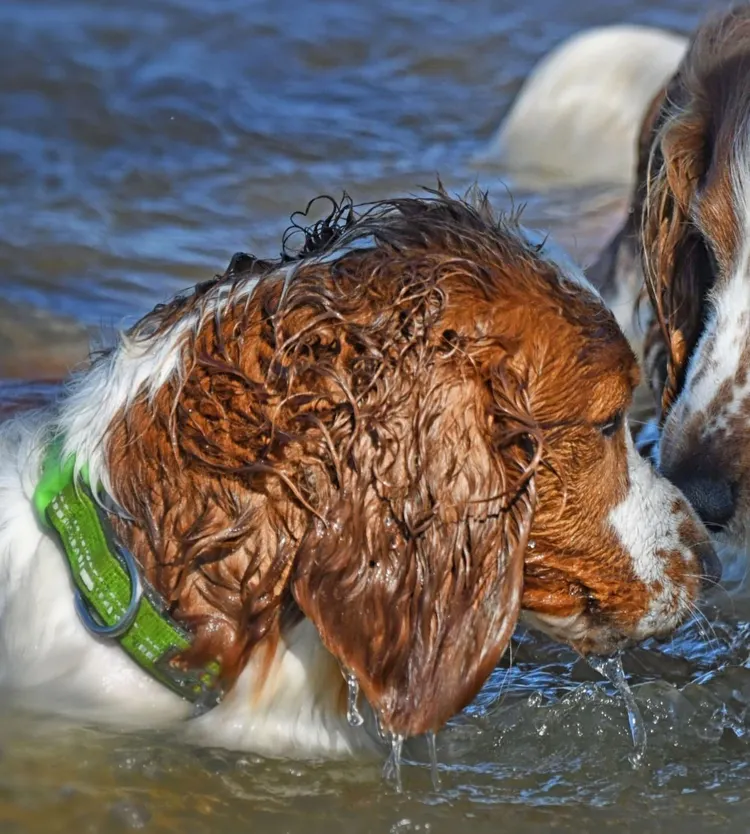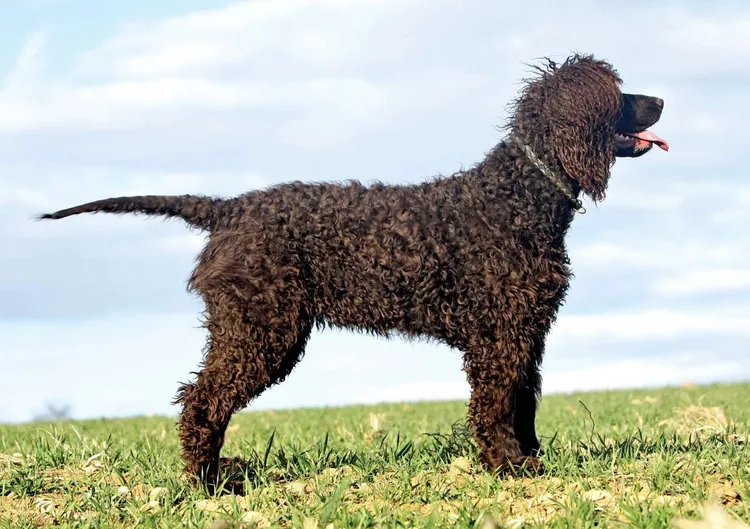Ever wondered where Golden Retrievers get their friendly personality and love for water? Meet the Tweed Water Spaniel, the long-lost ancestor that set the stage for one of the world’s most beloved dog breeds. Though now extinct, this remarkable dog played a vital role in shaping the retriever breeds we know today, particularly the Golden Retriever. Through its history, traits, and contributions, the Tweed Water Spaniel left a lasting legacy that continues to influence modern retrievers. Let’s dive into the history of this incredible breed and discover what made it so special.
The Origin and History of the Tweed Water Spaniel
Developed in the Scottish Borders: Named After the River Tweed
The Tweed Water Spaniel was primarily found along the River Tweed, located in the Scottish Borders, a region known for its rolling hills, rivers, and hunting culture. The breed was particularly popular with Scottish gamekeepers and hunters who required a versatile dog capable of working on both land and water. As the name suggests, this breed thrived near water, retrieving waterfowl and other game from the riverbanks.
Bred to withstand the cold and damp Scottish climate, the Tweed Water Spaniel combined the stamina needed for long days of work with a thick, curly coat that provided insulation in chilly waters. This coat and its strong swimming abilities made the breed invaluable for retrieving ducks and other waterfowl shot by hunters.
Role in Developing Golden Retrievers: Bred by Lord Tweedmouth
Perhaps the most significant contribution of the Tweed Water Spaniel was its role in the creation of the Golden Retriever. Lord Tweedmouth, a Scottish nobleman, is credited with developing the Golden Retriever in the mid-19th century. He began by selectively breeding his Tweed Water Spaniel with other retriever breeds, including the now-extinct St. John’s Water Dog and various spaniels, to create the versatile, gentle, and loyal breed that we know today as the Golden Retriever.
Lord Tweedmouth’s goal was to create a dog that could perform well in Scotland’s rugged terrain, retrieve game efficiently, and also have a friendly temperament. The Tweed Water Spaniel’s blend of intelligence, loyalty, and excellent working abilities made it the perfect foundation for this new breed.
Unique Lineage: A Blend of Spaniels and Water Dogs
The Tweed Water Spaniel had a distinct lineage that combined characteristics of both spaniels and water dogs, making it a strong swimmer and an eager worker. This mix of breeds resulted in a dog that could be highly adaptive to different terrains, excelling in both retrieving on land and navigating rivers and lakes with ease.
Though the breed eventually became extinct in the late 19th century, it left a profound impact on the development of other retriever breeds, particularly those used in hunting and retrieving tasks. Its genes live on through the Golden Retriever and other retriever breeds that inherited its physical and behavioral traits.
Characteristics and Temperament
Friendly and Loyal: Known for Its Bond with Owners
One of the standout characteristics of the Tweed Water Spaniel was its loyal and friendly nature. These dogs were known for forming strong bonds with their owners and being highly trainable, making them perfect companions for hunters and families alike. The breed had a keen desire to please, which made training them relatively easy, particularly for hunting and retrieving tasks.
Just like its descendant, the Golden Retriever, the Tweed Water Spaniel was gentle and friendly with children and adults alike. It was not known to be an aggressive breed, instead showcasing a calm demeanor and an affectionate personality.
Excellent Swimmer: Bred for Retrieving in Rivers and Lakes
Swimming was one of the breed’s key talents. The Tweed Water Spaniel was developed specifically for retrieving in cold waters, and its curly coat provided excellent protection against the elements. The breed’s strong swimming abilities made it particularly useful for retrieving game birds like ducks and geese, often shot over lakes or rivers.
In addition to their natural swimming skills, Tweed Water Spaniels were bred to have webbed feet, further enhancing their ability to paddle through the water with efficiency and speed. This trait has been passed down to their retriever descendants, making modern retrievers just as capable in aquatic environments.
Working Instincts: Desire to Please and Excel Outdoors
Like many working breeds, the Tweed Water Spaniel had a strong desire to please its owner. Whether it was retrieving game or simply following commands during training, this breed was known for its work ethic. These dogs were also excellent problem-solvers, traits that were essential in the hunting environment where they needed to navigate various terrains and situations.
The combination of intelligence and physical ability made the Tweed Water Spaniel a highly versatile worker, capable of performing a variety of tasks, from retrieving game to serving as a loyal companion to hunters.

Legacy in Modern Breeds
Golden Retriever Ancestry: Passing Down Traits Like Love for Water
The Tweed Water Spaniel’s influence is most directly seen in the Golden Retriever, which shares many of its ancestor’s traits. Golden Retrievers are known for their love of water, strong retrieving instincts, and friendly, gentle demeanor—characteristics that they inherited from the Tweed Water Spaniel.
Golden Retrievers continue to excel in tasks such as retrieving, search and rescue, and therapy work, showcasing the versatile talents passed down from their Tweed Water Spaniel ancestors. These traits have helped the Golden Retriever become one of the most popular and beloved dog breeds worldwide.
Influence on Other Spaniels and Retrievers
In addition to the Golden Retriever, the Tweed Water Spaniel also contributed to other retriever and spaniel breeds. Its characteristics can be seen in the Flat-Coated Retriever and the Irish Water Spaniel, both of which exhibit similar temperaments, working abilities, and physical traits. The breed’s influence extends beyond just the Golden Retriever, making it a foundational breed for several modern dogs.

Eco-Friendly Lessons from the Past
Responsible Breeding Practices: Ethics in Breeding
One of the lessons we can learn from the history of the Tweed Water Spaniel is the importance of responsible breeding. In the 19th century, breeding focused more on the dogs’ abilities and temperament rather than superficial characteristics. This ethical approach to breeding ensured that the best traits were passed on while minimizing health issues in the dogs.
Today, as we look to breed healthier, happier dogs, it’s essential to prioritize these same values. Responsible breeders focus on creating strong, healthy dogs that can excel in the tasks they were bred for, whether that’s retrieving, companionship, or agility.
Sustainability in Canine Care: Focus on Abilities Over Appearance
The legacy of the Tweed Water Spaniel also reminds us of the importance of sustainability in breeding and care. Breeding for abilities rather than appearance, as was done with the Tweed Water Spaniel, ensures that dogs are healthier and more suited for their intended roles. This philosophy aligns well with modern eco-conscious values, where the focus is on preserving the well-being of animals and minimizing harm to the environment.
Sustainable practices in canine care, such as using eco-friendly products, reducing waste, and providing dogs with natural, healthy diets, are ways that today’s dog owners can carry on the responsible breeding and care traditions of the past.
Conclusion
Though the Tweed Water Spaniel no longer roams the rivers of Scotland, its legacy lives on through its contributions to modern retriever breeds like the Golden Retriever. This extinct breed played a vital role in shaping some of today’s most beloved dogs, passing down traits like a love for water, loyalty, and strong working abilities. The Tweed Water Spaniel’s story is a reminder of the importance of responsible breeding practices and the lasting impact that ethical, thoughtful breeding can have on future generations of dogs. By honoring the history and contributions of breeds like the Tweed Water Spaniel, we can ensure that the dogs we love today continue to thrive in a sustainable, eco-friendly way.



